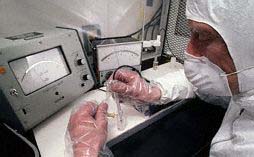CSPE Links
 Timor
Timor
 Cuba
Cuba
 Global Warming
Global Warming Africa I
Africa I  Argentina
Argentina  The Courts
The Courts  US Presidency
US Presidency  ASTI Strike
ASTI Strike  Attack
on America
Attack
on America
Scientists attempt to predict the consequences of increased carbon dioxide concentrations by using empirical evidence and Global Circulation Models (GCMs). The empirical evidence comes mainly from ice cores - long cylinders of ice extracted from the ice sheets over Greenland or Antarctica.

A scientist examines ice cores taken
from Antarctica
On both of these landmasses there are accumulations of ice that are 3km and 5km thick respectively. The ice has formed as yearly layers of snow have become crushed under new snowfalls. The deeper you travel into the ice sheet, the older the ice. As the ice forms bubbles of air get trapped and when examined they can tell us about the atmosphere at the time the ice was formed. The air in these bubbles can be analysed to determine carbon dioxide concentration and approximate air temperature. The evidence shows that carbon dioxide concentration has fluctuated in the past and when it increased so too did the air temperature.
Our second form of 'evidence' comes from GCMs that try to simulate the climate of today. These models are immensely complex and attempt to capture the chief components (clouds, oceans, ice, etc.) and interactions within the EAS. These models apply equations to millions of 'boxes' that represent sections of the EAS. However, they are still crude - even in the most powerful models, Ireland is represented by just two boxes.
Once these models are shown to be capable of producing the climate of today the characteristics of the atmosphere are changed by adding more carbon dioxide. The most commonly asked question of these models is: what will the climate be like if carbon dioxide concentration doubles? The answer to this question changes as the models themselves change. But, all models agree that increased carbon dioxide concentration will result in warming and that the effects of this warming will be greatest at higher latitudes.
In addition to this warming we can expect the ocean levels to rise, drowning many coastlines. The models suggest that some parts of the world will benefit from these changes but that most will fare badly. For Ireland these models indicate its average temperature will rise by 1.5 degrees Celcius, potentially expanding the growing season!


Our Planet

Kyoto Summit